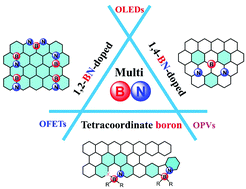Multiple-boron–nitrogen (multi-BN) doped π-conjugated systems for optoelectronics
Abstract
Boron–nitrogen-doped π-conjugated systems have been regarded as a class of organic materials with exceptional electronic and optical properties, which makes them promising in optoelectronic devices. Due to the isoelectronic relationship between the carbon–carbon (CC) unit and the boron–nitrogen (BN) unit, the location, number and orientation of BN units in π-conjugated systems bearing more than one BN unit are believed to have significant impacts on their electronic properties and intermolecular interactions. In addition, the coordination pattern of boron atoms in the conjugated systems could drastically tune their optoelectronic properties. This structural uniqueness makes these multiple-boron–nitrogen (multi-BN) doped π-conjugated systems exhibit great potential for application in organic light emitting diodes (OLEDs), organic photovoltaics (OPVs), and organic field-effect transistors (OFETs). This review covers recent advances in multiple boron–nitrogen doped π-conjugated systems including their synthetic strategies and applications in optoelectronic devices. We will rationalize the relationship between optoelectronic properties and the location, number and orientation of BN dopants as well as the coordination number of boron atoms, which could enlighten the design and synthesis of multi-BN-doped optoelectronic materials with better performances.

- This article is part of the themed collections: 2023 Journal of Materials Chemistry C Lunar New Year collection, 2022 Journal of Materials Chemistry C Most Popular Articles and Journal of Materials Chemistry C Emerging Investigators


 Please wait while we load your content...
Please wait while we load your content...